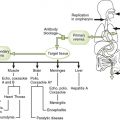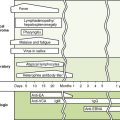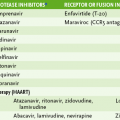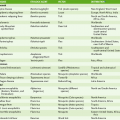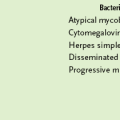Chapter 10 • Bacilli are large, gram-positive, aerobic, spore-forming rods that produce exotoxins. • B. anthracis is nonmotile (unlike other bacilli) and forms Medusa’s head colonies on blood agar. • Capsule composed of glutamic acid polymer prevents phagocytosis and antibody plus complement lysis. • Anthrax toxin causes localized edema and cell death; highly toxic. • Spores are extremely stable and can survive many years in soil, wool, hair, and animal hides. 2. Diseases caused by B. anthracis • Anthrax is an occupational disease of individuals who handle wools, furs, and hides. a. Cutaneous anthrax results from inoculation of spores or bacteria from soil or animal products into a superficial wound or abrasion. • Marked by initial itching papule at inoculation site; ulcer with vesicles that can lead to necrosis with massive edema, septicemia, and possible death • Most common form of anthrax in humans b. Pulmonary anthrax is due to inhalation of spores from contaminated items such as wool, fur, and hides. c. Gastrointestinal anthrax results from ingestion of bacteria in contaminated meat. • Vaccination of animals and proper disposal of infected animals are important in controlling anthrax. • Human vaccination is restricted to at-risk individuals (fur and wool handlers, military) and those living where disease is endemic. • Prompt therapy is essential to reduce risk for death: amoxicillin if penicillin sensitive, otherwise ciprofloxacin (a fluoroquinolone). • B. cereus, a ubiquitous soil organism found in grains, vegetables, and dairy products, is the most common pathogenic bacilli. • Emetic form is caused by preformed heat-stable enterotoxin ingested in reheated foods (e.g., rice and beans). a. Rapid onset (similar to S. aureus food poisoning); nausea, vomiting, and abdominal cramps developing within 1 to 5 hours after eating toxin-containing food • Diarrheal form is caused by heat-labile enterotoxin produced by bacteria multiplying in the gastrointestinal (GI) tract following ingestion of contaminated meat, vegetables, or sauces. • Refrigeration of foods after cooking a. Spores survive initial cooking and will germinate into toxin-producing vegetative cells if foods are not refrigerated properly. Later reheating inactivates heat-labile toxin but does not affect vegetative cells or heat-stable toxin. • Supportive therapy (e.g., replenish fluids and electrolytes) C Bacillus subtilis and other Bacillus species • Four clostridial species are important human pathogens: C. botulinum, C. difficile, C. perfringens, and C. tetani. • Clostridia are gram-positive, anaerobic (or aerotolerant), spore-forming rods that produce potent exotoxins. • C. perfringens is found worldwide in soil, water, and sewage; normal inhabitant of the GI tract. • Large, boxcar-shaped, aerotolerant, rapidly growing rods • Double zone of hemolysis on blood agar • Positive Nagler reaction (characteristic diffuse zone around colonies grown on egg yolk agar) • Subtypes A to E defined based on production of major toxins • Type A C. perfringens is most virulent in humans. a. Alpha toxin (phospholipase C and lecithinase), produced by all types, causes lysis of blood cells and endothelial cells, leading to increased vascular permeability, hemolysis, and tissue destruction. b. Hyaluronidase, collagenase, and other degradative enzymes cause tissue destruction.
Gram-Positive Toxigenic Rods
![]()
Stay updated, free articles. Join our Telegram channel

Full access? Get Clinical Tree



